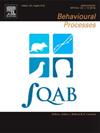Time estimation variability in delay discounting: Model comparison and considerations
IF 1.5
4区 生物学
Q4 BEHAVIORAL SCIENCES
引用次数: 0
Abstract
Delay discounting describes an organism’s sensitivity to delayed consequences. The advent of hyperboloid discounting models introduced the s discounting parameter, a fitted metric that reduces residual variance when working with human subjects. Mathematically, discounting s allows for a nonlinear relation between consequence (A) and delay (D) and could be conceptually accounted for as a psychophysical scalar that describes subjective differences in the rate of time passage. This study offers a proof-of-concept examination of hyperboloid s in relation to participant time-based experiences. A crowdsourced sample of adults (N = 211) completed tasks measuring time estimation (i.e., reporting how much time passed during a distractor task) and temporal distance estimation (i.e., reporting how temporally distant a delay feels). Participants generally underestimated durations in the time estimation task, where income and completion of a preceding day-framed discounting task (versus date-framed), but not Myerson and Green’s s (b = −0.19), and modestly Rachlin’s s (b = 0.82), exhibited a statistically significant relation with time estimation accuracy. Similarly, participant age and delay framing, but not hyperboloid s, exhibited a statistically significant relation with temporal distance estimation discrepancies. Broadly, data suggest that s may not be accounting for differences in time estimation as measured in this sample. At most, the modest effect observed for Rachlin’s s suggests limited conceptual value, meriting further consideration of the metric’s account of subject-level differences.
延迟折扣中的时间估计可变性:模型比较和考虑。
延迟贴现描述了生物体对延迟后果的敏感性。双曲面折现模型的出现引入了折现参数,这是一个拟合的度量,在与人类受试者一起工作时减少了剩余方差。从数学上讲,贴现s允许结果(a)和延迟(D)之间的非线性关系,并且可以在概念上解释为描述时间流逝速度的主观差异的心理物理标量。本研究提供了双曲面s与参与者基于时间的经验的概念验证检验。一个由成年人组成的众包样本(N = 211)完成了测量时间估计(即报告在分心任务中花了多少时间)和时间距离估计(即报告延迟的时间距离)的任务。参与者普遍低估了时间估计任务的持续时间,其中收入和完成前一天的折扣任务(相对于日期框架),但Myerson和Green的s (b = -0.19)和Rachlin的s (b = 0.82)与时间估计准确性表现出统计学上显著的关系。同样,参与者的年龄和延迟帧,而不是双曲面s,与时间距离估计差异表现出统计学上显著的关系。总的来说,数据表明s可能没有考虑到在这个样本中测量的时间估计的差异。至多,对Rachlin’s s观察到的适度效应表明,概念价值有限,值得进一步考虑该指标对主体水平差异的解释。
本文章由计算机程序翻译,如有差异,请以英文原文为准。
求助全文
约1分钟内获得全文
求助全文
来源期刊

Behavioural Processes
生物-动物学
CiteScore
2.70
自引率
7.70%
发文量
144
审稿时长
4-8 weeks
期刊介绍:
Behavioural Processes is dedicated to the publication of high-quality original research on animal behaviour from any theoretical perspective. It welcomes contributions that consider animal behaviour from behavioural analytic, cognitive, ethological, ecological and evolutionary points of view. This list is not intended to be exhaustive, and papers that integrate theory and methodology across disciplines are particularly welcome.
 求助内容:
求助内容: 应助结果提醒方式:
应助结果提醒方式:


